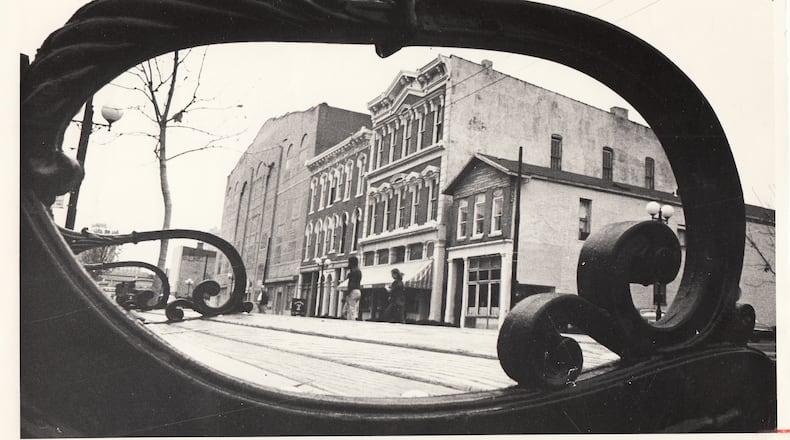In January 1829, Brainard Smith recorded the first Oregon plat. This was made up of 27 building lots bounded by East Fifth, Jackson and sides of East Sixth Street. Those building lots sold for a grand total of $220.
About that time, large numbers of German immigrants began to arrive in Dayton.
After the opening of the Miami Canal, the Oregon District was largely settled by those German immigrants, who built several area churches. This area includes the Tecumseh Street plat of 1839, where the earliest houses of the district stand — the most complete group of early Dayton buildings in the city.
Oregon name
The origin of the name “Oregon” is uncertain, though it emerges in early newspapers around 1845. Readers of the Dayton Journal and Advertiser saw an ad that read, “I have laid out and offer for sale on terms to suit purchasers, 80 desirable building lots in that part of the city known as Oregon.”
It was posted by David Z. Pierce, an early developer who wanted to attract buyers to his new plat in the busy area east of the Miami-Erie canal.
In the second half of the 19th century the district prospered, and commercial and residential development and mansions were built amid the smaller homes.
Forty-two years later, in 1887, the last plat was completed, and the Oregon area was considered complete. At that time, the Oregon area was the home to some of Dayton’s most prominent citizens.
The Great Flood of 1913 started an era of decline for the Oregon District. The flood covered the area in 10 feet of water, and afterward many residents began moving to higher ground. World War I and II continued this decline, and by the 1960s the city considered a proposal to save 125 of the buildings and demolish the rest. That proposal failed due to lack of funding.
Name change
During a time of revitalization in 1960s and ‘70s, the city of Dayton renamed the area the Burns-Jackson Historic District.
Early plans of that time called for the razing of many historic commercial buildings along East Fifth Street and part of Wayne Avenue.
These included the Blood Hardware Store, Walden’s Hall and Block building, Moses Glas building, Balsley Block building and the John A. Becker Electric Co. building, which was also known as the Elias Heathman building.
In 1966, Martin J. Kelly, a local history enthusiast, wrote in a Dayton Daily News column that “the old name Oregon deserves consideration for reinstatement, for it is the true, historical name of the area.
The name was later changed to the Oregon Historic District, and the area was placed on the Nation Register of Historic Places in 1974.
Expansion
In 1979, there was a lot of activity in the Oregon District, but it wasn’t the kind that store owners liked.
There were mounds of dirt and huge holes in the road. The air was filled with the sounds of jackhammers, dump trucks and tractors.
Crews were working on a $500,000 refurbishing of East Fifth Street between Patterson and Wayne.
The street was being narrowed so the sidewalks could be wider. Trees, shrubs, flower planters, benches and turn-of-the-century lamps were being added.
A huge S-shaped planter was built where Clay Street dead-ended into East Fifth Street near Wayne Avenue. A grand piano-shaped retaining wall was being built at the edge of the planter.
• FROM THE ARCHIVES: 31 historic photos of the Oregon District
The work also included new sidewalk curbs. At least 25 caverns for freight elevators that were once situated in the sidewalks were removed as a safety measure.
Modern times
Today, the Oregon District is made up of 12 city blocks and home to a wide range of businesses, from arts and entertainment to retail stores, bars and restaurants.
One can visit and see the Oregon District in all its glory during First Fridays. On the first Friday of every month, Fifth Street comes alive with art and culture.
About the Author






